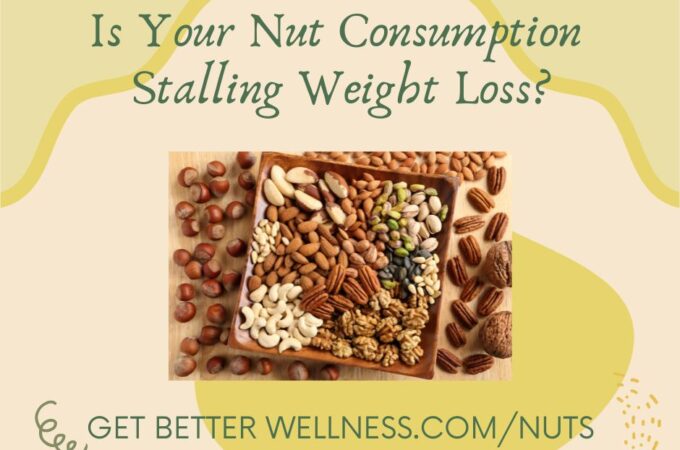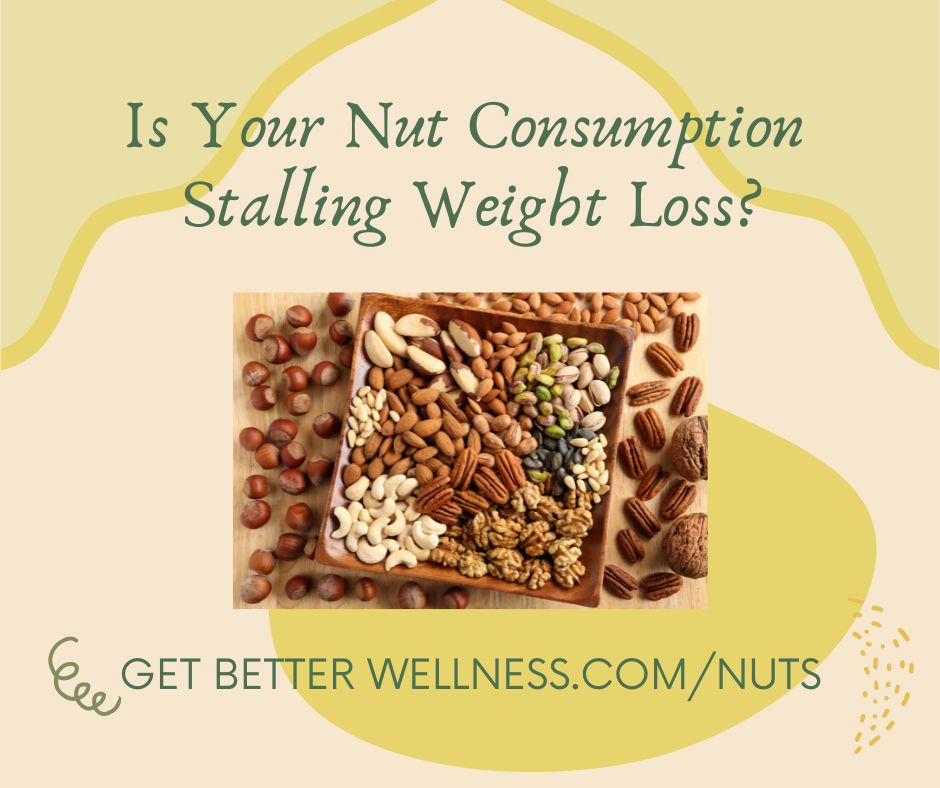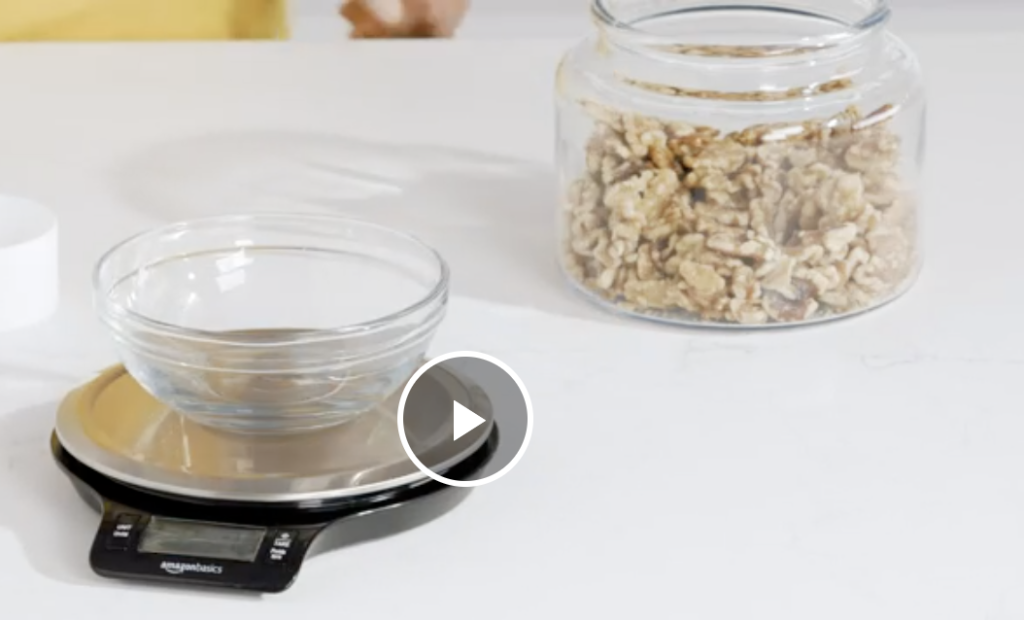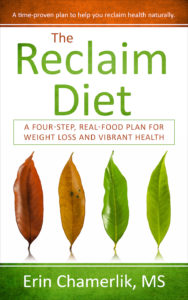
Nuts – Beneficial or Caution?
Nuts are a concentrated source of fat and carbohydrate. It is easy to grab one handful, then another, then another.
My recommendation when it comes to nuts is portion control. It is easy to eat too many nuts because they are not all that satiating in recommended amounts (one ounce).
Plus, when we eat salted nuts, that makes them more irresistible.
What is the recommended serving size of nuts?
Limit nuts to 1oz (a handful or 1/4 cup) once or twice a day at most.
High Carb Nuts
Different nuts have varying amounts of carbs.
- Cashews are high in carbs, 9g/oz.
- Pistachios are high in carbs, 9g/oz.
- Grabbing 3 handfuls can easily add up to 27g carbs which is more carbs than most snacks need to be, more than a piece of bread.
Low to Medium Carb Nuts
Lower carb nuts include: Macadamia, Pili nuts, Pecans, Walnuts, Pine nuts.
Almonds are medium at 6g, but they are on the high-oxalate list. I had to quit almonds and almond butter because it hurt my stomach.
How many carbs can we eat in a day?
There is no one-size-fits-all for how many carbs are too many for an individual. I am very carb sensitive, meaning my blood sugar shoots up if I consume too many carbs. When I consume carbohydrates they are only from whole, real foods (fruit, vegetables, seeds, nuts), so I personally have to scale my carbs way down.
Lab tests can help you figure out how many carbs you tolerate.
Get a fasting insulin and hemoglobin A1C. Order it yourself from DirectLabs.com or UltaLabTests.com. The cost of these tests will be $55-60. Ulta Lab charges a blood draw fee of $8.95 while Direct Labs does not currently charge a draw fee. Check both labs as test go on sale routinely.
- The Hemoglobin A1C is a three month average of your blood sugar. Ideally, you will run 4.7 – 5.3 or lower for those eating very low carb or ketogenic eating plans.
- The fasting insulin target is below 6μU/mL. Over 10 is a concern.

Is Your Nut Consumption Stalling Weight Loss?
Some people who are trying to lose weight may be eating too many nuts.
If you feel you are eating too many nuts or you aren’t sure if they are giving you problems, try cutting all nuts out for a few weeks and then test nuts one type at a time with controlled portions.

One idea to help with portion control is to use a food scale to measure out 1oz of nuts, and package them in little baggies so that you are aware of your consumption.
Antinutrients in Nuts
Antinutrients are chemicals found in certain plants that bind vitamins and minerals and prevent your body from absorbing nutrients. Some of the health problems caused by eating too many antinutrients include inflammation, digestive issues and brain fog.
While there are certain steps you can take (soaking, sprouting, fermenting) to reduce the negative effects of antinutrients, most people do not have the expertise or the time required to properly prepare nuts, grains and legumes, so limit your intake.
Soaking and sprouting seeds and nuts will increase the ability to digest the food and absorb more nutrients, but it does not completely remove all antinutrients.
Antinutrients include: oxalates, phytic acid and lectins. Lectins and phytic acid can bind minerals (iron, zinc, magnesium, calcium) in nuts, making them unavailable to you as a nutrient. Soaking and sprouting seeds and nuts will increase the ability to digest the food and absorb more nutrients, but it does not completely remove all antinutrients.
Oxalates occur naturally in most plants. Oxalates are normally broken down by healthy bacteria in our digestive tract. For those who have a compromised gut (from poor diet, gut infections, toxins, antibiotic use, stress, food allergies) this normal breakdown of oxalates may not be happening. When oxalates enter the bloodstream instead of being excreted from the body, crystals can form, causing pain and inflammation.
Foods highest in oxalates per serving include rice, buckwheat, rhubarb, wheat, corn, soy, navy beans, almonds, spinach, beets, beet greens. Minimizing the amount of foods high in oxalates may help improve joint pain, signs of aging and autoimmune conditions.
Build your diet around unprocessed foods.
We focus on eating traditional, natural foods to achieve optimal health.
The bulk of the diet is based on eating:
- Quality animal foods (beef, pork, venison, bison, poultry, seafood, organ meats, eggs and bone broth).
- Healthy fats (butter, lard, tallow, olive oil, avocado oil, coconut oil, macadamia nut oil, nuts, seeds, olives, coconut, and avocado).
- Colorful vegetables non-starchy, low oxalate vegetables.
- Some fruit can tuck in here and there. It is best eaten as a dessert following a meal containing protein, fat and vegetables. Fruit can be paired with a healthy fat to keep your blood sugar stable (berries with coconut milk, 1/2 apple with sunflower seed butter). Eating fruit without fat/protein is not recommended because it will not be as satiating, it will increase your blood sugar too fast, and leave you wanting more carbs.
My overall recommendation is to avoid snacking and eat three meals a day. Then stop eating after dinner until breakfast the next day.
Examples of Foods Containing Healthy Fats:
| Olives, cured (no vinegar) | Grass-fed meat |
| Avocado, guacamole | Wild-caught fatty fish |
| Coconut, coconut milk | Free-range eggs |
| Nuts* (about ¼ cup, 1-2 times a day) | Fish oil |
| If dairy is tolerated: heavy cream, cheese | MCT oil |
Learn more, get my book, The Reclaim Diet.
Get Better Wellness is reader supported. This post may contain affiliate links, which means that I may receive a small commission when you buy from links on this site. This is at no cost to you.
Recommended
-
Dandelion for Liver Support and Health BenefitsJuly 20th, 2024
-
Modified Citrus PectinJuly 11th, 2024
-
Bentonite Clay Mask for Face and ArmpitsJuly 8th, 2024
-
Two Supplements for Erectile DysfunctionJune 30th, 2024









